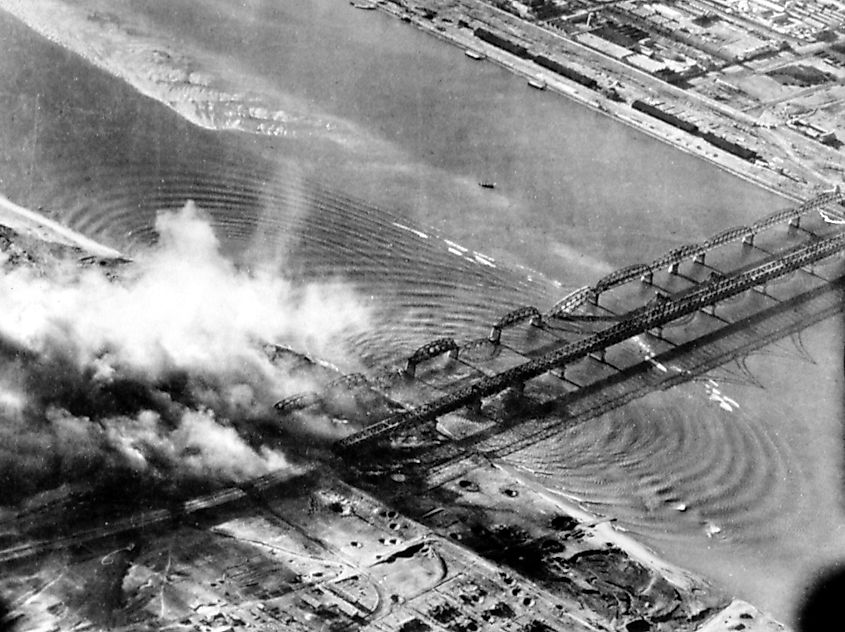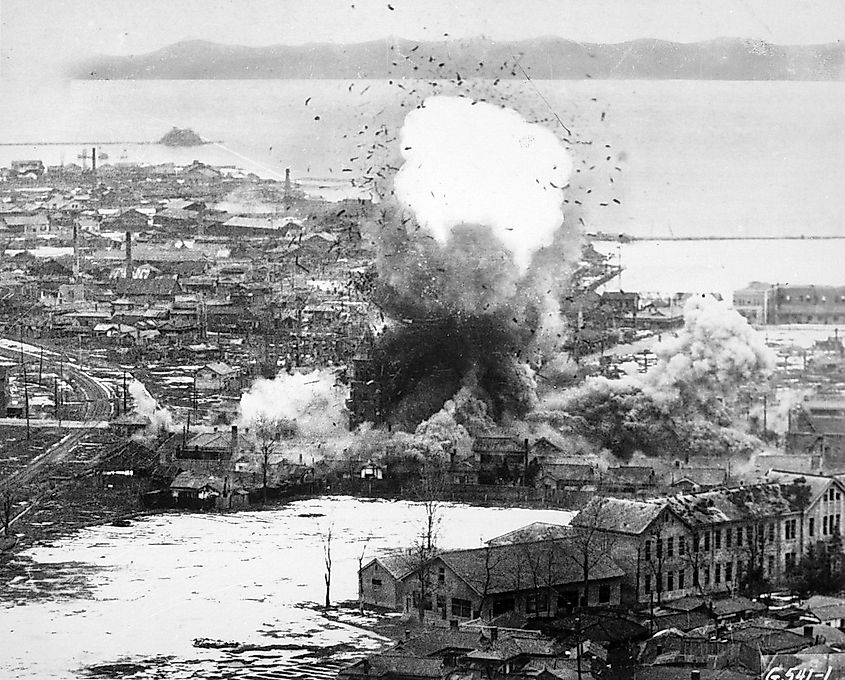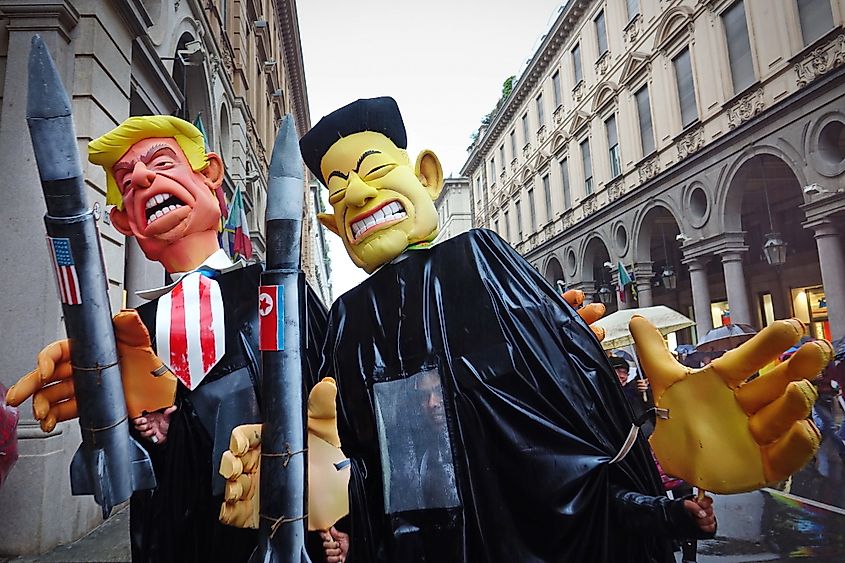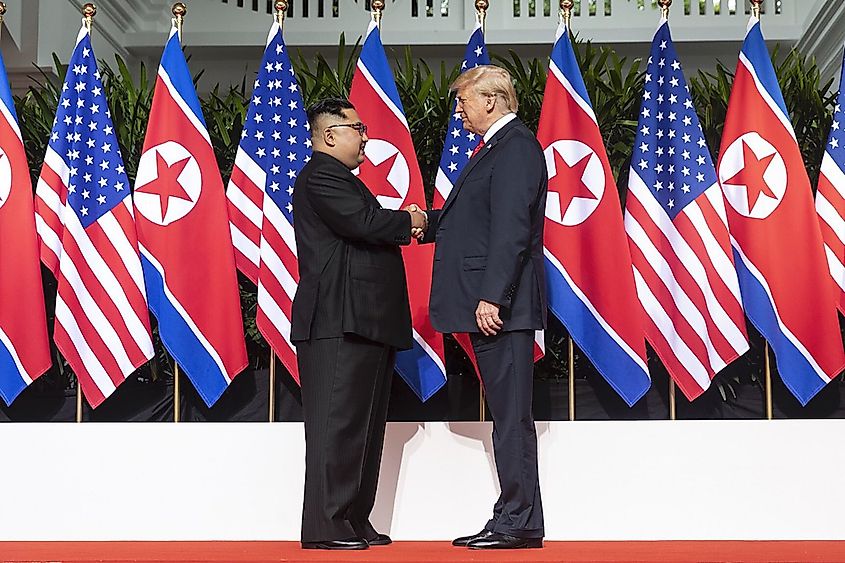The United States-North Korea Relations

- The United States and North Korea have no formal diplomatic relations.
- Relations between the United States and North Korea have repeatedly shifted from periods of reconciliation to periods of hostility.
- Despite American efforts to curb North Korea's nuclear activities, North Korea is now known to have several nuclear weapons at its disposal.
Arguably, the most volatile relationship that the United States has with another country is its relationship with North Korea. To this day, North Korea and the United States have no formal diplomatic relations. Since the Korean War (1950-1953), the United States has maintained a very tense relationship with North Korea. This relationship has been characterized by both periods of reconciliation and periods of dangerous escalation in hostilities between the two countries. Relations between the United States and North Korea have implications for the entire region, and even the entire world, especially in light of the fact that North Korea has managed to develop nuclear weapons.
Historical Background

After Japan surrendered at the end of WWII, the 35-year Japanese occupation of the Korean Peninsula ended. The peninsula was then divided into two occupied zones separated by the 38th parallel. The southern zone was controlled by the United States, while the north was controlled by the Soviet Union. Efforts to reunite the Korean Peninsula failed, and in 1948, the two occupied zones became two independent countries. The north became the Democratic People’s Republic of Korea (DPRK), which came to be known as North Korea, while the south became the Republic of Korea, or South Korea, as it is commonly known. North Korea was governed by a communist regime backed by the Soviet Union and the People’s Republic of China, while the south had a strongly pro-American, anti-communist government.

On June 25, 1950, North Korea invaded the south, attempting to unite the peninsula by force. They were opposed by an American-led multinational military force backed by the United Nations. The Soviet Union supported the North Koreans with weapons and air support, while the Chinese became directly involved in the fighting with hundreds of thousands of combat troops. The Korean War ended in 1953 with an armistice that placed a ceasefire line and a demilitarized zone (DMZ) roughly dividing the Koreas into two equal parts. But no treaty was ever signed formally ending the Korean War.

The Cold War
Following the Korean War, the communist regime in North Korea believed that it faced an existential crisis, as they thought that the United States could wipe them out at any time. Thus, they felt that they needed to develop some sort of capability that would deter the Americans from attacking. This was the point when the North Koreans first began to entertain the possibility of creating a nuclear arsenal. It would be another 30 years, however, before the North Koreans would come close to achieving nuclear capabilities.
In the early 1980s, with the help of the Soviet Union, the North Koreans built their first nuclear power plant in Yongbyon. They insisted that their pursuit of nuclear energy was peaceful. In fact, in 1985, North Korea signed on to the Nuclear Non-Proliferation Treaty. Six years later, they signed an agreement with South Korea, which pledged the two countries into promising never to produce or use nuclear weapons. Still, the North Koreans refused to allow the International Atomic Energy Agency (IAEA), to access their facilities in order to confirm that they were fulfilling their treaty obligations.
From The Brink Of War To Reconciliation
The collapse of the Soviet Union in 1991 put North Korea in a very tight spot. For decades, the USSR helped the North Koreans build up their economy and military forces. After the Soviet Union dissolved, however, North Korea was left with China as its sole remaining ally. This new, post-Cold War reality may have persuaded North Korea’s communist regime to behave more desperately, as it did in 1994, when it seemed that war with the United States was close at hand.
In June 1994, the North Koreans shut down their power plant at Yongbyon and removed spent fuel rods from it. Fearing the rods would be used to produce nuclear weapons, the United States tried to push economic sanctions on North Korea at the United Nations Security Council. At the same time, American military reinforcements were sent to South Korea. What could have turned into a war, however, was averted by the intervention of former US President Jimmy Carter, who began negotiating with the North Koreans for an agreement that would settle the matter of the communist country’s nuclear activities. Carter’s breakthrough was followed up by then US President Bill Clinton. By October, the Americans and North Korea agreed on a framework by which the communist country would freeze its nuclear development and dismantle its nuclear facilities in exchange for greater normalization with the United States.
From 1994 onward, it seemed that the United States and North Korea were moving towards reconciliation. In fact, in 2000, the US Secretary of State even visited North Korea’s capital, Pyongyang, and met with the country’s leader, Kim Jong Il. It was hoped that a visit from the US President himself would follow. But this did not happen, and with a change in the US administration, relations between the United States and North Korea again began to deteriorate.
United States-North Korean Relations in the 21st Century

Since the dawn of the new millennium, relations between the United States and North Korea have gone from reconciliatory to downright hostile on several occasions. When George W. Bush assumed the US Presidency in 2001, for example, he called off normalization talks with North Korea. But a diplomatic breakthrough came again in 2003, when the so-called Six Party Talks began, which involved not only the United States and North Korea, but also South Korea, Russia, China, and Japan. Again, however, no major progress was made. In the meantime, North Korea has conducted several nuclear and ballistic missile tests over the last two decades, causing relations between it and the United States to deteriorate further. It is now estimated that North Korea now has several nuclear weapons at its disposal.

North Korean Leader Kim Jong-un (left) and US President Donald Trump (right), June 2018.
Another opportunity for peace came in 2018, when meetings between high level officials of both countries took place, including a meeting between US President Donald Trump and North Korean leader Kim Jong Un. A second meeting took place between the two leaders in 2019. They agreed to work towards the denuclearization of the Korean Peninsula with security guarantees for North Korea, and a framework for peace between the two countries. In 2020, however, President Trump was voted out of office. The new US President, Joe Biden, has reportedly rejected Trump’s policies towards North Korea, so it is unclear if the breakthrough that Trump supposedly made with the North Koreans will lead to further progress towards peace between the two countries.











